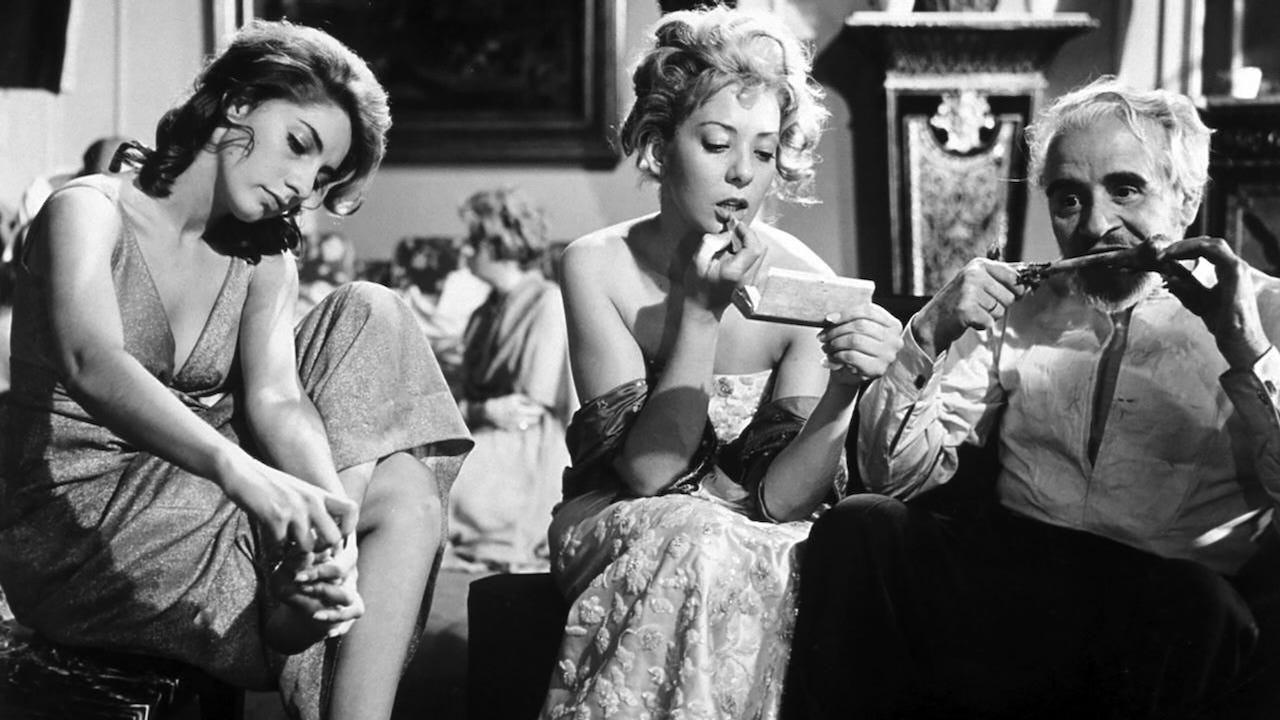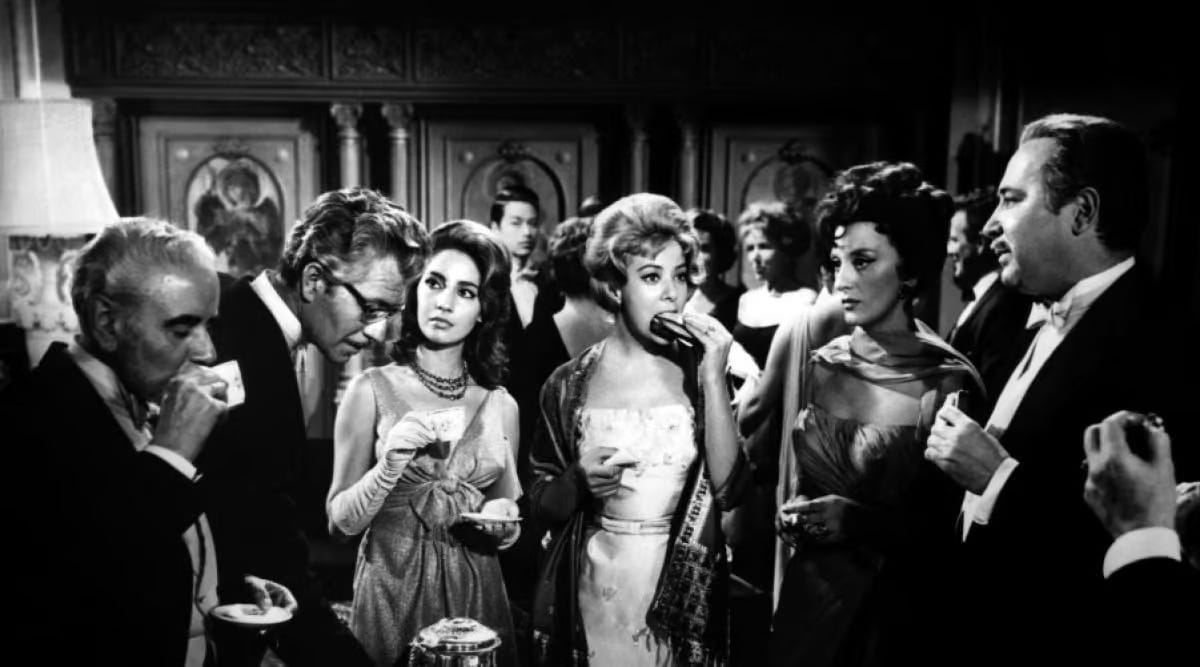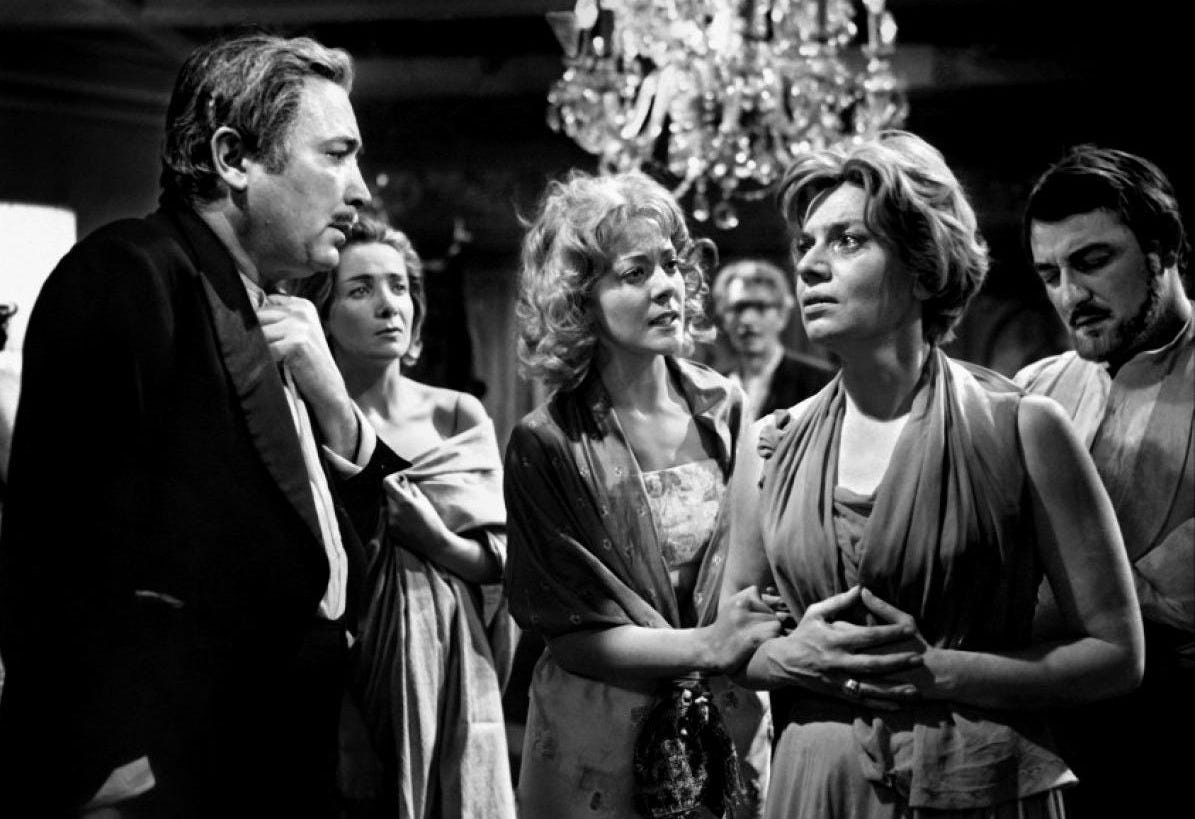The worst party guest is the one who won’t leave. Unless, of course, they can’t leave—a predicament that transforms Luis Buñuel’s The Exterminating Angel from social satire into existential horror.
[Please be aware that plot details for The Exterminating Angel, and therefore certain aspects of Here We Are’s second act, follow.]
If The Discreet Charm of the Bourgeoisie shows us a group of wealthy socialites who can never quite begin their dinner party, The Exterminating Angel (1962) presents us with its nightmare inverse: guests who can never leave. Once again, Buñuel uses a deceptively simple premise to craft a devastating critique of social order, one that would provide fertile ground for Act II of Sondheim’s Here We Are sixty years later.
The film opens conventionally enough: after an opera performance, a group of high-society guests arrives at the luxurious mansion of Edmundo and Lucia Nóbile for a late-night dinner party. The first sign that something is amiss comes when we see the servants inexplicably leaving the house, apparently feeling an urge to escape. Only the butler, Julio, remains. After dinner, when it comes time for the guests to depart, they find themselves unable to leave the drawing room. There is no physical barrier—the doors remain open—but an invisible force keeps them trapped inside.
What follows is a gradual descent into barbarism as social niceties crumble in the face of prolonged confinement, the guests’ inability to leave becoming a metaphor for the self-imposed prisons of social class and ritual.
These trapped party guests form a microcosm of upper-class society:
Edmundo and Lucia Nóbile
The hosts, whose veneer of perfect hospitality slowly cracks as the situation deteriorates. In Here We Are, their role is primarily assumed by Leo, the charming billionaire whose heart attack becomes a physical manifestation of the hosts’ loss of control. Where Buñuel’s hosts fail in their duty to provide, Leo’s crisis suggests the broader collapse of patriarchal authority.
Leticia “The Valkyrie”
An opera singer whose performed sophistication gives way to raw survival instinct. Sondheim and his collaborators transmute her into Marianne, the “ethereal” figure with “unexpected lyricism” who, like her predecessor, ultimately discovers the key to their escape. Both characters suggest art’s ambiguous role in social crisis—at once prophet, witness, and potential savior.
Dr. Carlos Conde
A voice of rational science who attempts to maintain order even as the situation defies logical explanation. His counterpart in Here We Are is Paul, whose “laid-back, low-key” demeanor masks an “under layer of anxiety”—a telling update that transforms scientific certainty into educated skepticism.
Raúl and Ana Maynar
A married couple whose relationship frays under the pressure of confinement. Sondheim and Ives boldly reimagine this dynamic through Fritz and the Soldier, whose romance blossoms rather than deteriorates in captivity. This revision suggests both the possibility of genuine connection amid social collapse and the particular resonance of forbidden love in confined spaces.
Francisco and Rita Ávila
Elderly siblings whose concerns about Rita’s illness highlight the physical vulnerabilities that privilege usually keeps at bay. While these characters have no direct equivalents in Here We Are, the notion of physical frailty is distributed among the ensemble, particularly in the group’s increasingly desperate search for water.
Unlike The Discreet Charm’s episodic structure, The Exterminating Angel unfolds as a single sustained nightmare. The drawing room becomes a petri dish where Buñuel can examine just how quickly civilization deteriorates when its supporting structures are removed. The guests begin by maintaining decorum—adjusting their clothes, making polite conversation—but as hours stretch into days, their façade cracks. They sleep on floors, fight over water, and eventually resort to breaking into pipes to survive. Yet even in their degradation, they cling to vestigial traces of their class identity, like aristocrats maintaining protocol in a lifeboat.
This tension between social performance and animal necessity provides rich material for musical adaptation. In Here We Are, Sondheim and his collaborators transform the drawing room into a contemporary meditation on privilege and imprisonment. The musical’s second act opens with the guests already trapped, their initial confusion giving way to the dawning horror that they cannot leave. As in Buñuel’s film, the barrier is psychological rather than physical—a distinction that allows Sondheim to explore how we become complicit in our own confinement.
The genius of Buñuel’s concept lies in its ambiguity: are the guests truly trapped by some supernatural force, or have they simply lost the will to leave? The film offers no clear answer, and this uncertainty becomes central to its critique. The invisible barrier might represent class consciousness, social obligation, or the fear of breaking ranks with one’s peers—all themes that Sondheim explored richly throughout his career.
Indeed, the parallels between The Exterminating Angel and Sondheim’s earlier work are striking. The drawing room setting recalls the claustrophobia and paralysis of Company, where Bobby is similarly trapped by social expectations. The breakdown of civility among Buñuel’s guests echoes the second act of Into the Woods, whose fairy tale characters face moral collapse in the face of crisis.
As the situation in the drawing room deteriorates, Buñuel introduces a parallel plot outside the mansion. A crowd gathers to watch the house, unable to enter just as the guests are unable to leave. This mirror image of confinement suggests that the barrier works both ways—the privileged classes are as trapped by their status as others are by their exclusion from it. When sheep and other animals begin appearing inexplicably in the house, the imagery recalls the surrealist touches of The Discreet Charm, but here they serve a darker purpose: as civilization breaks down, the natural world encroaches.
The film’s resolution emerges from an unlikely idea: Leticia suggests that by returning to their exact positions from the first night and reenacting their actions precisely, they might break free. This solution—essentially staging a performance of their original gathering—brilliantly underscores Buñuel’s theme of social ritual as both prison and possible salvation. In Here We Are, this becomes a deliciously meta-theatrical sequence in which those on stage must literally rehearse their way to freedom.
Significantly, The Exterminating Angel’s exploration of ritual and repetition connects to Sondheim’s career-long interest in patterns and their breaking. The film’s central irony—that the guests must meticulously recreate their entrance to engineer their escape—speaks directly to one of Sondheim’s most persistent themes: the way we so often trap ourselves in patterns of behavior even as we dream of breaking free. We see it in Bobby’s ritualized birthday celebrations in Company. We hear it in Ben’s obsessive return to his failed marriage in Follies, where “The Road You Didn’t Take” is both confession and self-deception. Perhaps most tellingly, we find it in A Little Night Music’s intricate roundelay of postponement, where characters perpetually defer action with promises of “Now/Later/Soon.”
In adapting The Exterminating Angel, Sondheim and his collaborators found a perfect metaphor for this human tendency: characters who must become conscious of their social performances before they can transcend them. After all, as A Little Night Music reminds us, “perpetual anticipation is good for the soul, but it’s bad for the heart”—and these characters, too, must break free from expectation before they can move forward.
Yet where Buñuel’s film ends with the guests finally escaping (only to find themselves trapped again, this time in a church), Here We Are suggests a different kind of resolution. The musical’s ending, while maintaining the existential anxiety of its source material, offers a more nuanced meditation on the nature of social bonds. If Act I (adapted from The Discreet Charm) shows us the impossibility of meaningful connection in a world of empty ritual, Act II explores how crisis might force us to confront the real meaning of community.
Together, these two Buñuel films offered Sondheim and his collaborators an ideal framework for Here We Are. Where The Discreet Charm of the Bourgeoisie provided the satirical structure of perpetually thwarted desire, The Exterminating Angel offered something darker and more profound: a laboratory for examining how civilization itself might unravel. In adapting the latter film, Sondheim found fresh theatrical language for questions that had animated his work for decades: How do our social performances both sustain and constrain us? What happens when ritual fails to provide the structure we expect? And perhaps most importantly, how might we recognize the boundaries we’ve drawn around ourselves?
In the drawing room of The Exterminating Angel, as in the embassy salon of Here We Are, we witness not just a social crisis but an existential one—the uncomfortable recognition that the walls most difficult to breach are often those we ourselves maintain.
Summoning Sondheim returns to London:
UK-based readers, see this short message below from the lovely people behind Summoning Sondheim:
Grace O’Keefe (Best Newcomer at Musical Comedy Awards 2024 and co-creator of five-star EdFringe sell-out Bad Teacher) and Jordana Belaiche (West End Credits: Little Cosette in Les Misérables, Jane in Mary Poppins, yes, really) host this silly little spooky séance. Their goal? To summon Sondheim’s spirit in order to save musical theatre and therefore, the world. Running from March 26th to April 7th, get your tickets now before the show heads to 54 Below in NYC this fall: https://www.tickettailor.com/events/vaultcreativearts/1533873








What couldn’t that man do?♥️